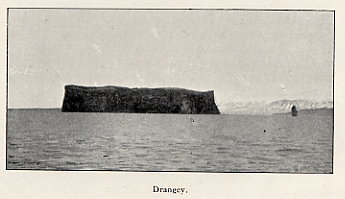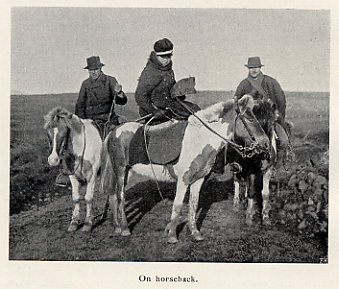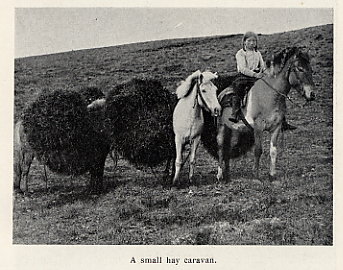| |
For the Tourist, who will not be satisfied by making one
of the traditional, I am almost tempted to say, to
commonplace Tours, which all strangers are induced to — for
the Tourist, who is a real out-door man, and does not mind
spending a few days in uninhabited regions, I would
recommend a ride through the deserted inner Highlands from North
to South, or vice versa.
Take the route over Kjölur! All that is characteristic in

Drangey.
Icelandic scenery will then spread itself out before us:
Through a broad smiling thickly-populated valley —
Skagafjördur — where nature exhibits itself in all its richness and
abundance, our road winds up over the hill of the coast
districts to the mightly, desolate, and yet so splendid
Highland plain bordered by the white domes of the glaciers'
perpetual ice. Here our way passes over desert sands, across
rapid rivers, and lava fields black as a ravens wing to a
mighty crater, and to mountain tarns rich in feathered life!
Then on again down towards the inhabited plains of the
South — to Gullfoss, Geysir, Thingvellir and Reykjavík.
The ship heads up the 20 mile long and comparatively
broad Skagafjord. But already before we have fast ground
under our feet, before we have trodden this traditional soil
with its memories of a thousand years, the shape of the little
Island Orangey appears in sight and reminds us vividly of
the past.
The rock island raises itself a hundred fathoms sheer out
of the blue water, not unlike a square fort. Nature has here
on this detached part of Iceland formed a place of defence,
where the Saga hero, Grettir the Strong, spent the last three
years of his life as an outlaw. It was from here, that
Grettir, once when his fire had gone out, swam ashore — nearly
five miles — to fetch more; an unrivalled performance.
When he had spent three years on the island, which is only
200 fathoms long and 50 wide, he was at last surprised and
killed; he had then only one year more to pass before he
would have been a free man again; but his foes grudged
him the freedom he had sighed for for twenty slowly
passing years. Grettir the Strong is one of the great heroes of
Icelandic Saga, and was a real hero. Countless are the
stories of his courage, cunning, and strength, and mementos of
his illustrious career are frequently to be found in the north.
At the top of the island the site of his abode may still be
seen. Orangey is now uninhabited, but for six weeks during
the spring, bird-catching goes on briskly here; specimens of
the auk species, (the Guillemot, Auk, & Puffin) forming the
principle booty. The birds are caught in a peculiar manner
by means of large rafts on which the snares are spread,
live specimens being used as decoys. Now as in olden days
sheep are grazed on the island both summer and winter.
We come into Skagafjord, past Drangey and the other
splendid islands, which adorn this Fjord, whilst the hills
rise on the right and left, their summits, may be, capped with
snow.
Straight before us, to the South, we see the white houses
of the trading station Saudárkrókr, lying on the strand be-
neath the hills at the end of the Fjord. — Still further south
we see the broad Skagafjords valley, where the sun sparkles
and the refraction gives small islets, eminences, and farms
an exaggerated height. In the far south, at the end of the
valley — lies a blue conical mountain, the top of which is
quite white. This is Mælifellshnjúkur which stretches
skyward over all the neighbouring hills, and can be seen from
far around, even from right in the middle of the country,
whither we are bound. The Parsonage farm Mælifell lies at
the foot of the mountain, while the farm Gilhagi lies a little
farther south in the dale.
The ship casts anchor in the bay opposite the town, a
boat comes out, and we are landed at one of the small piers
belonging to the traders. We are at once surprised at the
many small elegant wooden houses, which are all painted in
light and pleasant colours. There are several streets, a little
Hotel, where one can spend the night, a church, and several
rather large tradesmens shops where stock of provisions may
be obtained; and further a group of other houses belonging
to artizans, fishermen and others. The place is further
honoured by a clergyman, and an official acting as judge and
revenue officer of the district.
The arrival of the steamer is generally marked by the
presence of a number of peasants in the town. Especially

On horseback.
after the wool-shearing in the early summer, they come to
the trading station with their caravans. The horses are faste-
ned one behind the other with the wool bales hanging from
either side of the pack-saddles. Towards evening one caravan
after the other starts out, the people kissing one another
good bye once, twice, thrice, or even oftener, indifferent
whether on horseback or on foot; and the men start off at
a wild pace, which is kept up for a short distance,—in fact
they perform a kind of „ Fantasia" like the Arabs on similar
occasions.
The evening is far advanced before the last caravan has
departed, but in the shops the lights still burn for some
time longer, while the accounts for the day are made up.
A few stragglers still sit in the inn, while the horses wait
patiently without, but finally the last straggler topples out
and climbs uncertainly on to his horse. — It is touching to
see how the horse even seems to try to help him over his
difficulties, and assist him in preserving his balance by fol-
lowing as nearly as possible his toppling movements. As a
matter of fact the temperance movement has made great
strides in Iceland in later years.
It is the time of the light nights. Galloping and shouting,
the motley crowd leave the town at eventide; but soon the

A small hay caravan.
pace is slackened, and the easy even trot begins, which
makes such steady progress. One family after another reach
home to their farms, where the dogs are barking; others
keep on the whole night through — and a part of the next
day may be —, before they reach their homesteads at the
end of the valleys.
|
|





![]() Zurück zu Inhalt
Zurück zu Inhalt![]() nächstes Kapitel
nächstes Kapitel